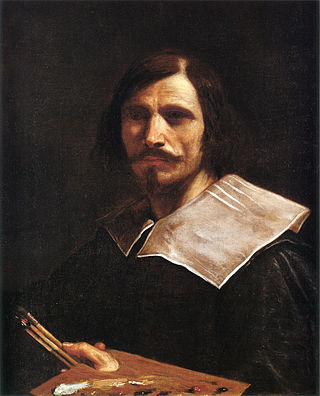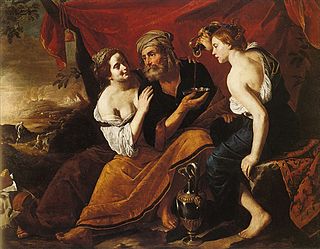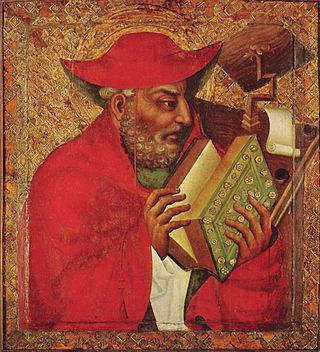Saint Jerome is a Christian church father, best known for translating the Bible into Latin.
Saint Jerome may also refer to:

Giovanni Francesco Barbieri, better known as (il) Guercino, was an Italian Baroque painter and draftsman from Cento in the Emilia region, who was active in Rome and Bologna. The vigorous naturalism of his early manner contrasts with the classical equilibrium of his later works. His many drawings are noted for their luminosity and lively style.
San Juan Bautista is the Spanish-language name of Saint John the Baptist. It may refer to:

BartolomeoMontagna was an Italian Renaissance painter who mainly worked in Vicenza. He also produced works in Venice, Verona, and Padua. He is most famous for his many Madonnas and his works are known for their soft figures and depiction of eccentric marble architecture. He is considered to be heavily influenced by Giovanni Bellini, in whose workshop he might have worked around 1470. Benedetto Montagna, a productive engraver, was his son and pupil and active until about 1540. He was mentioned in Vasari's Lives as a student of Andrea Mantegna but this is widely contested by art historians.

Jusepe de Ribera was a Spanish painter and printmaker. Ribera, Francisco de Zurbarán, Bartolomé Esteban Murillo, and the singular Diego Velázquez, are regarded as the major artists of Spanish Baroque painting. Referring to a series of Ribera exhibitions held in the late 20th century, Philippe de Montebello wrote "If Ribera's status as the undisputed protagonist of Neapolitan painting had ever been in doubt, it was no longer. Indeed, to many it seemed that Ribera emerged from these exhibitions as not simply the greatest Neapolitan artist of his age but one of the outstanding European masters of the seventeenth century." Jusepe de Ribera has also been referred to as José de Ribera, Josep de Ribera, and Lo Spagnoletto by his contemporaries, early historians, and biographers.
Saint John the Baptist is a religious figure in Christianity, Islam, and Mandaeanism.
The Annunciation is the biblical episode of the announcement by the archangel Gabriel to Mary that she would become the mother of Jesus.
Holy Family is a Christian term for Jesus, the Virgin Mary and St. Joseph.

The Basilica of Saint Nicholas of Tolentino is a Roman Catholic church and minor basilica that is part of the Augustinian monastery in the hill-town of Tolentino, province of Macerata, Marche, central Italy. The church is a former cathedral of the Roman Catholic Diocese of Tolentino, suppressed in 1586.

Bartolomeo Cavarozzi (1587–1625), occasionally referred to as Bartolomeo Crescenzi, was an Italian caravaggisti painter of the Baroque period. Cavarozzi's work began receiving increased admiration and appreciation from art historians in the last few decades of the 20th century, emerging as one of the more distinct and original followers of Caravaggio. He received training from Giovanni Battista Crescenzi in Rome and later traveled to Spain alongside his master for a few years where he achieved some renown and was significant in spreading "Caravaggism" to Spain before returning to Italy. His surviving works are predominantly Biblical subjects and still-life paintings, although older references note he "was esteemed a good painter especially of portraits".

Hendrick de Somer (1602–c.1655) was a Flemish painter who spent most of his life and career in Italy. He was mainly active in Naples.

Matthias Stom or Matthias Stomer was a Dutch, or possibly Flemish, painter who is only known for the works he produced during his residence in Italy. He was influenced by the work of non-Italian followers of Caravaggio in Italy, in particular his Dutch followers often referred to as the Utrecht Caravaggists, as well as by Jusepe de Ribera and Peter Paul Rubens. He did not share the other Northern Caravaggisti's preference for humorous, and sometimes scabrous, genre scenes and elaborate decorative allegories but favored stories from the bible instead. He worked in various locations in Italy where he enjoyed the patronage of religious institutions as well as prominent members of the nobility.
The Pietà is a subject in Christian art depicting the Virgin Mary cradling the dead body of Jesus.
Penitent Magdalene or Penitent Magdalen refers to a post-biblical period in the life of Mary Magdalene, according to medieval legend, and a large number of artworks showing this subject, including:
Saint John or St. John usually refers to John the Baptist, but also, sometimes, to John the Apostle.

The Galleria Estense is an art gallery in the heart of Modena, centred around the collection of the d’Este family: rulers of Modena, Reggio and Ferrara from 1289 to 1796. Located on the top floor of the Palazzo dei Musei, on the St. Augustine square, the museum showcases a vast array of works ranging from fresco and oil painting to marble, polychrome and terracotta sculpture; musical instruments; numismatics; curios and decorative antiques.
Saint Peter and Saint Paul may refer to:
Saint Luke or Luke the Evangelist, one of the Four Evangelists.

The Pinacotecta Nazionale is an art gallery in Ferrara, Emilia-Romagna, Italy. It is located on the piano nobile of the Palazzo dei Diamanti, a work of Renaissance architecture by Biagio Rossetti, commissioned by Leonello d’Este in 1447. Not to be confused with the Civic Museum on the lower floor, which has hosted temporary exhibitions of contemporary art since 1992, the Pinacoteca houses a collection of paintings by the Ferrarese School dating from the thirteenth to the eighteenth centuries. It was founded in 1836 by the Municipality of Ferrara after Napoleon's widespread dissolution of churches threatened the protection of important public artworks. The gallery is formed as much around notable northern Italian painters as it is around the exquisite interior decoration of the palace itself, together with remnants of frescoes from local churches and later acquisitions from the Sacrati Strozzi collection.

Saint Luke the Evangelist is one of the most impressive panel paintings by Master Theodoric, intended for the decoration of the Chapel of the Holy Cross in Karlštejn. It may be a self-portrait of Theodoric himself. It is exhibited in the collection of medieval art of the National Gallery in Prague.

Saint Jerome is one of the finest paintings by Master Theodoric in the Chapel of the Holy Cross at Karlštejn. He has an honourable place in the hierarchy of the Holy Fathers and his portrait is placed in the south window niche of the chapel together with St. Augustine, St. Ambrose and St. Gregory. It is one of the oldest and most frequently reproduced depictions of St. Jerome. The painting is exhibited in the collection of medieval art of the National Gallery in Prague.